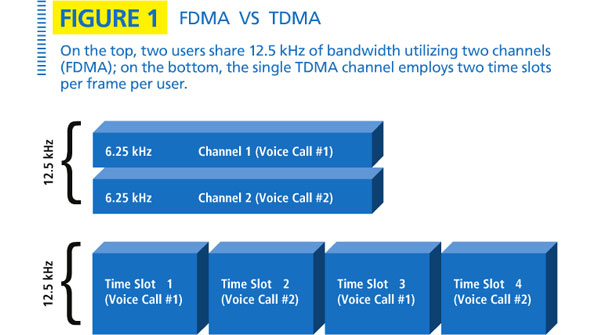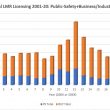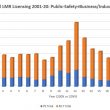A fine line
Users in the VHF and UHF bands (below 512 MHz) face a mandatory FCC narrowbanding deadline of Jan. 1, 2013. Narrowbanding is a spectrum-efficiency requirement that initially requires the equivalent of at least one user per 12.5 kHz for voice channels or capacity of at least 9.6 kbps per 12.5 kHz for data channels. The FCC intends to further squeeze VHF and UHF land mobile radio channels to 6.25 kHz (or equivalent), but no formal deadline has been established for this second phase. However, many licensees are choosing 6.25 kHz-compliant solutions now to avoid expensive upgrades in the future.
The narrowbanding deadline forces licensees to make technology decisions, particularly decisions regarding the multiple access method. This is the technique used to share radio spectrum among multiple simultaneous users. There are three basic techniques used in land mobile and cellular radio: frequency division multiple access (FDMA), time division multiple access (TDMA) and code division multiple access (CDMA). FDMA separates users by frequency — each user occupies its own radio channel. TDMA separates users by time — each user occupies the entire radio channel, but at different time slots. The differences between FDMA and TDMA are shown in Figure 1 (right). On the top, two users share 12.5 kHz of bandwidth utilizing two channels (FDMA); on the bottom, the single TDMA channel employs two time slots per frame per user.
CDMA separates users by a set of spread-spectrum codes. Users share the same frequency at the same time, but the code set has good cross-correlation and auto-correlation properties that allow users to be separated at the radio receiver using a spread-spectrum correlator. CDMA with 1.25 MHz channels is used today by Verizon Wireless, Sprint, Cricket, Alltel and other cellular operators, but it is not under consideration for land mobile radio primarily because the FCC has not allocated sufficient spectrum for CDMA radio channels. The argument for land mobile radio users then really comes down to FDMA versus TDMA.
The other technology choice forced by narrowbanding is digital versus analog. The effect of narrowbanding on analog FM radios was covered in the April 2010 issue of this magazine, so we won’t cover this topic here, other than to state that analog FM radios are limited to FDMA systems and it is not practical to operate analog FM on 6.25 kHz channels, as the FCC’s spectrum mask cannot be met. For our purposes, we will assume that both FDMA and TDMA systems are digital.
In practice, TDMA systems are really a combination of FDMA and TDMA. Radio channels are allocated in some fashion, say 25 kHz or 12.5 kHz, and two to four users share each radio channel using separate time slots. TDMA systems include Project 25 Phase II, TETRA, and proprietary systems such as Motorola’s Mototrbo. FDMA systems for 6.25 kHz channels include NXDN (jointly developed by Icom and Kenwood) and dPMR (digital private mobile radio, an ETSI standard). Vendors supporting TDMA products created an advocacy organization called the Digital Mobile Radio Association (DMR) which can be found at dmrassocation.org. Similarly, FDMA vendors have their own organizations: nxdn-forum.com and dpmr-mou.org.
Because the FCC already has allocated the VHF and UHF bands using relatively narrow channels at the maximum (i.e., 25 kHz), the practical problem is how best to use the allocated channel. Should we employ FDMA and further subdivide the frequency channel into smaller user channels, or should we retain the radio channel width and share the channel using TDMA time slots? In a perfect theoretical world where brick-wall filters are realizable and no practical implementation problems exist, one could attain the same spectrum efficiency with either FDMA or TDMA. In the real world, several issues must be considered:
- Receiver sensitivity.
- Adjacent channel interference and the near-far problem.
- Battery life.
- Spectrum planning and licensing issues.
- Transmitter combiner costs.
- Oscillator frequency drift from crystal aging.
- Peer-to-peer mode.
Let’s examine each of these issues in turn.
Receiver sensitivity. The TDMA receiver requires a wider intermediate frequency (IF) bandwidth so, all else being equal, the FDMA receiver should have better sensitivity and therefore better coverage.
Adjacent channel interference and the near-far problem. Because of practical filter-implementation problems, increasingly narrow channel allocations are not able to maintain the same channel selectivity as wider channels. In other words, channel selectivity does not scale perfectly. Consequently, narrowband receivers generally are more susceptible to adjacent-channel interference. For example, from Appendix A of TSB-88.1-C, we see an 11 dB difference in adjacent-channel power between NXDN at 6.25 kHz offset and P25 Phase I at 12.5 kHz offset. This interference is one example of the near-far problem, where a strong nearby transmitter desensitizes a receiver trying to capture a weak signal from a distant user. The difference in performance can be mitigated through good frequency planning at the expense of spectrum efficiency.
Battery life. Battery life is affected in large part by the radio transmitter. TDMA advocates often cite the fact that a two-slot TDMA radio transmits only 50% of the time, so battery life must be longer in the TDMA radio. In practice, TDMA radios may have longer battery life, but this advantage is not due entirely to the time-slot duty cycle. All else being equal, both TDMA and FDMA receivers require the same energy per bit for acceptable performance. In other words, the two-slot TDMA radio must transmit twice the transmit power to have the same energy per bit as the FDMA radio.
Spectrum planning and licensing. This might be the area where TDMA offers the best advantage. The FDMA system must be licensed for each individual channel; in contrast, the TDMA user simply leverages his already-licensed channel by dividing it into time slots. Also, because alternating 6.25 kHz channels exist on 12.5 kHz channel centers, adding a new adjacent 6.25 kHz channel creates energy outside the spectrum mask of the original 12.5 kHz channel. This situation can create adjacent-channel short-spacing problems, depending on the location of adjacent-channel repeaters and users.
Transmitter combiner costs. The transmitter combiner at the repeater site allows multiple radios to share the same antenna. FDMA systems must have one transmitter port for each user, while TDMA systems require one transmitter port for each radio channel. Consequently, an existing combiner with 12.5 kHz channels requires no modifications for a TDMA conversion, but it does require a 2:1 expansion for a 6.25 kHz FDMA system. Alternatively, the FDMA manufacturer might use hybrid combiners in the radio chassis to combine adjacent 6.25 kHz channels before they hit the cavity filter at the combiner.
However, a licensee may not want adjacent channels in his system because of the near-far problem among his own users.
Oscillator frequency drift. The subscriber radio employs a crystal oscillator that serves as the frequency reference for the receiver’s local oscillator. As the crystal ages, its frequency drifts. Periodic frequency alignments can correct for this drift, but a narrower channel filter is more sensitive to this problem. As a reference point, consider that most radio manufacturers use a fixed 16-kHz filter for both 25 kHz and NPSPAC channels, despite the fact that adjacent-channel performance at 12.5 kHz is relatively poor.
In other words, the practical tradeoff to date has favored the wider filter. So, for 6.25 kHz channels, the IF filter must be widened, which creates adjacent-channel and near-far problems, or the frequency specification must be tightened. This problem may be solvable through adaptive filtering or other means, but the solution likely will add cost and complexity to the radio. The licensee should ask the vendor how this problem is addressed in his design.
Peer-to-peer (talk-around) mode. TDMA systems typically operate through radio repeaters, but land mobile radio users often operate in peer-to-peer mode. Most TDMA solutions revert to a single FDMA channel in peer-to-peer mode. The P25 standards committee is considering a two-slot TDMA peer-to-peer mode, so talk-around communications may be available in such systems in the near future.
Licensees have different priorities, so the choice between FDMA and TDMA is not “one size fits all.” In the end, cost may be the deciding factor.
Jay Jacobsmeyer is president of Pericle Communications Co., a consulting engineering firm located in Colorado Springs, Colo. He holds bachelor's and master's degrees in electrical engineering from Virginia Tech and Cornell University, respectively, and has more than 25 years experience as a radio-frequency engineer.













